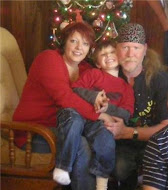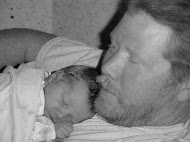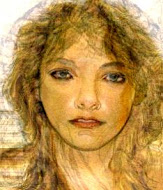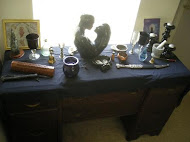- So the wheel turns. Mabon has passed and Samhain is fast approaching... seemingly much faster than it did when I was a child. Before you know it, Yule will be knocking on our doors! Before that happens, let's explore Samhain for a while... * Halloween Moon Omens * -author unknownIf the moon is new on Samhain, this indicates that the coming year will be fertile ground for new beginnings to take place, such as the start of a new project, a new career, or even a new way of thinking. For those desiring children, a new moon at Samhain is a lucky omen, indicating a new birth within a year's time. If the moon is waxing on Samhain, this indicates good luck throughout the coming year. It also indicates growth and an increase of all things that are positive nature. If the moon is full on Samhain, this ensures that the powers of all forms of magic and divination practiced on this night will be at their greatest. A secret wish made at midnight will be realized within the coming year. Do not be surprised if an experience of a psychic nature awaits you in the very near future. If the moon is waning on Samhain, this can be an omen of either good or bad consequences. It can indicate the elimination of such things as bad habits, unhealthy relation-ships and obstacles within the coming year. Or it can point to a decrease (such as in one's health) or a loss of some kind soon to take place. If the moon is in the dark phase on Samhain, this is believed to be a very negative omen. Exercise extreme caution in all of your endeavors within the next twelve months, and it wouldn't hurt to protect yourself by wearing or carrying any type of amulet or talisman designed to ward off bad luck and misfortune.
- * The Origins of Halloween * By Rowan Moonstone published in CAULDRONS AND BROOMSTICKS - A newsletter for and by the Pagan/Wiccan Internet Community - SAMHAIN issue 1999.
- In recent years, there have been a number of pamphlets put out by various Christian organizations dealing with the origins of modern day Halloween customs. Being a Witch myself, and a student of the ancient Celts, from whom we get this holiday, I have found these pamphlets woefully inaccurate and poorly researched. In an effort to correct some of this erroneous information, I have spent several months researching the religious life of the ancient Celtic peoples and the survivals of that religious life in modern day times. Listed below are some of the most commonly asked questions concerning the origins and customs of Halloween. Following the questions is a lengthy bibliography where the curious reader can go to learn more about this holiday than space permits.
- Where does Halloween come from?
Our modern celebration of Halloween is a descendent of the ancient Celtic fire festival called "Samhain". The word is pronounced "sow-in", with "sow" rhyming with cow.
-
- What does "Samhain" mean? The Irish English dictionary published by the Irish Texts Society defines the word as follows: "Samhain, All Hallowtide, the feast of the dead in Pagan and Christian times, signalizing the close of harvest and the initiation of the winter season, lasting till May, during which troops (esp. the Fiann) were quartered. Faeries were imagined as particularly active at this season. From it the half year is reckoned. also called Feile Moingfinne (Snow Goddess). The Scottish Gaelis Dictionary defines it as
- (1) "Hallowtide. The Feast of All Soula. Sam + Fuin = end of summer." (2) Contrary to the information published by many organizations, there is no archaeological or literary evidence to indicate that Samhain was a deity. The Celtic Gods of the dead were Gwynn ap Nudd for the British, and Arawn for the Welsh. TheIrish did not have a "lord of death" as such.
- Why was the end of summer of significance to the Celts?
The Celts were a pastoral people as opposed to an agricultural people. The end of summer was significant to them because it meant the time of year when the structure of their lives changed radically. The cattle were brought down from the summer pastures in the hills and the people were gathered into the houses for the long winter nights of story- telling and handicrafts.
- What does it have to do with a festival of the dead?
The Celts believed that when people died, they went to a land of eternal youth and happiness called Tir nan Og. They did not have the concept of heaven and hell that the Christian church later brought into the land. The dead were sometimes believed to be dwelling with the Fairy Folk, who lived in the numerous mounds or sidhe (pron. "shee") that dotted the Irish and Scottish countryside. Samhain was the new year to the Celts. In the Celtic belief system, turning points, such as the time between one day and the next, the meeting of sea and shore, or the turning of one year into the next were seen as magical times. The turning of the year was the most potent of these times. This was the time when the "veil between the worlds" was at its thinnest, and the living could communicate with their beloved dead in Tir nan Og.
- What about the aspects of "evil" that we associate with the night to-day?
The Celts did not have demons and devils in their belief system. The fairies, however, were often considered hostile and dangerous to humans because they were seen as being resentful of men taking over their lands. On this night, they would sometimes trick humans into becoming lost in the fairy mounds, where they would be trapped forever. After the coming of the Christians to the Celtic lands, certain of the folk saw the fairies as those angels who had sided neither with God or with Lucifer in their dispute, and thus, were condemned to walk the earth until judgment day. (3) In addition to the fairies, many humans were abroad on this night, causing mischief. since this night belonged neither to one year or the other, Celtic folk believed that chaos reigned and the people would engage in "horseplay and practical jokes". (4) This served also as a final outlet for high spirits before the gloom of winter set in.
- What about "trick or treat"?
During the course of these hijinks, many of the people would imitate the fairies and go from house to house begging for treats. Failure to supply the treats would usually result in practical jokes being visited on the owner of the house. Since the fairies were abroad on this night, an offering of food or milk was frequently left for them on the steps of the house, so the homeowner could gain the blessings of the "good folk" for the coming year. Many of the households would also leave out a "dumb supper" for the spirits of the departed. (5) The folks who were abroad in the night imitating the fairies would sometimes carry turnips carved to represent faces. This is the origin of our modern Jack-o-lantern.
- Was this also a religious festival?
Yes. Celtic religion was very closely tied to the Earth. Their great legends are concerned with momentous happenings which took place around the time of Samhain. Many of the great battles and legends of kings and heroes center on
this night. Many of the legends concern the promotion of fertility of the earth and the insurance of the continuance of the lives of the people through the dark winter season.
- How was the religious festival observed?
Unfortunately, we know very little about that. W.G. Wood-Martin, in his book, "Traces of the Elder Faiths of Ireland" states, "There is comparatively little trace of the religion of the Druids now discoverable, save in the folklore of the peasantry, and the references relative to it that occur in ancient and authentic Irish manuscripts are, as far as present appearances go, meagre (sic) and insufficient to support anything like a sound theory for full development of the ancient religion. " (6) The Druids were the priests of the Celtic peoples. They passed on their teachings by oral tradition instead of committing them to writing, so when they perished, most of their religious teachings were lost. We DO know that this festival was characterized as one of the four great "Fire Festivals" of the Celts. Legends tell us that on this night, all the hearth fires in Ireland were extinguished, and then re-lit from the central fire of the Druids at Tlachtga, 12 miles from the royal hill of Tara. This fire was kindled from "need fire" which had been generated by the friction of rubbing two sticks together as opposed to more conventional methods common in those days. (7) The extinguishing of the fires symbolized the "dark half" of the year, and the re-kindling from the Druidic fires was symbolic of the returning life hoped for, and brought about through the ministrations of the priesthood.
- What about sacrifices?
Animals were certainly killed at this time of year. This was the time to "cull" from the herds those animals which were not desired for breeding purposes for the next year. Most certainly, some of these would have been done in a ritualistic manner for the use of the priesthood.
- Were humans sacrificed?
Scholars are sharply divided on this account, with about half believing that it took place and half doubting its veracity. Caesar and Tacitus certainly tells tales of the human sacrifices of the Celts, but Nora Chadwick points out in her book "The Celts" that "it is not without interest that the Romans themselves had abolished human sacrifices not long before Caesar's time, and references to the practice among various barbarian peoples have certain overtones of self- righteousness. There is little direct archaeological evidence relevant to Celtic sacrifice." (8) Indeed, there is little reference to this practice in Celtic literature either. The only surviving story echoes the story of the Minotaur in Greek legend. The Fomorians, a race of evil giants said to inhabit portions of Ireland before the coming of the Tuatha de Danaan, or "people of the Goddess Danu", demanded the sacrifice of 2/3 of the corn, milk, and first born children of the Fir Bolg, or human inhabitants of Ireland. The De Danaan ended this practice in the second battle of Moy Tura, which incidentally took place on Samhain.
- What other practices were associated with this season?
Folk tradition tells us of many divination practices associated with Samhain. Among the most common were divinations dealing with marriage, weather, and the coming fortunes for the year. These were performed via such methods as ducking for apples, and apple peeling. Ducking for apples was a marriage divination. The first person to bite an apple would be the first to marry in the coming year. Apple peeling was a divination to see how long your life would be. The longer the unbroken apple peel, the longer your life was destined to be. (9) In Scotland, people would place stones in the ashes of the hearth before retiring for the night. Anyone whose stone had been disturbed during the night was said to be destined to die during the coming year.
- How did these ancient Celtic practices come to America?
When the potato crop in Ireland failed, many of the Irish people, modern day descendents of the Celts, immigrated to America, bringing with them their folk practices, which are the remnants of the Celtic festival observances.
- We in America view this as a harvest festival. Did the Celts also view it as such?
Yes. The Celts had 3 harvests: August 1, Lughnassadh or Lammas, was the first harvest, when the first fruits were offered to the Gods in thanks. The Fall Equinox, also known as Mabon, was the "true harvest". This was when the bulk of the crops would be brought in. Samhain was the final harvest of the year. Anything left on the vines or in the fields after this date was considered blasted by the fairies, or "pu'ka", and unfit for human consumption.
- Does anyone today celebrate Samhain as a religious observance?
Yes. many followers of various pagan religions, such as Druids and Wiccans observe this day as a religious festival. They view it as a memorial day for their dead friends, similar to the national holiday of Memorial Day in May. It is still a night to practice various forms of divination concerning future events. Also, it is considered a time to wrap up old projects, take stock of ones life, and initiate new projects for the coming year. As the winter season is approaching, it is a good time to do studying on research projects and also a good time to begin hand work such as sewing, leather working, woodworking, etc. for Yule gifts later in the year.
- Does this involve human or animal sacrifice?
Absolutely NOT! Hollywood to the contrary, blood sacrifice is not practiced by modern day followers of Wicca or Druidism. There may be some people who THINK they are practicing Wicca by performing blood sacrifices, but this is NOT condoned by reputable practitioners of the modern day Neo-Pagan religions.
FOOTNOTES:
- (1) Rev. Patrick Dineen, "An Irish English Dictionary" (Dublin, 1927), p. 937 (link is to the full book, available on line)
- (2) Malcolm MacLennan, "A Pronouncing and Etymological Dictionary of the Gaelic Language" (Aberdeen, 1979), p. 279
- (3) W.G. Wood-Martin, "Traces of the Elder Faiths of Ireland" (Port Washington, 1902), p. 5. (link is to the full book, available on line)
- (4) Kevin Danaher, "The Year in Ireland", (Cork, 1972), p. 214
- (5) Alwyn & Brinley Rees, "Celtic Heritage" (New York, 1961), p. 90
- (6) Traces of The Elder Faiths of Ireland Wood-Martin, p. 249 (link is to the full book, available on line)
- (7) Alwyn & Brinley Rees, "Celtic Heritage" (New York, 1961), p. 90
- (8) Nora Chadwick, "The Celts" (Harmondsworth, 1982), p. 151
- (9) Madeleine Pelner Cosman, "Medieval Holidays and Festivals," (New York, 1981), p. 81
Disclaimer: No one involved in this blog or its contents may be held responsible for any adverse reactions arising from following any of the instructions/recipes on this list. It is the reader's personal responsibility to exercise all precautions and use his or her own discretion if following any instructions or advice from this blog.















No comments:
Post a Comment